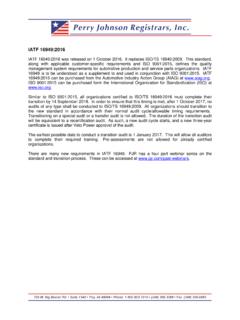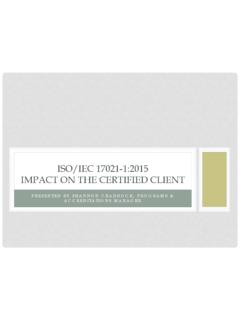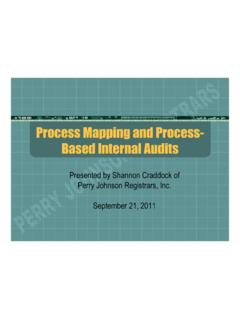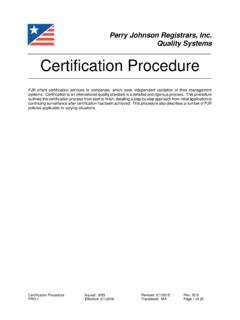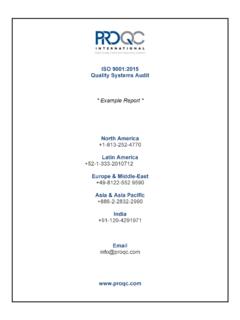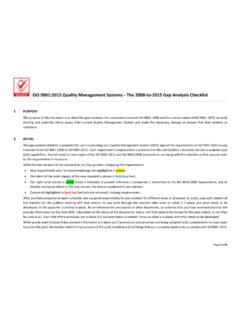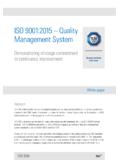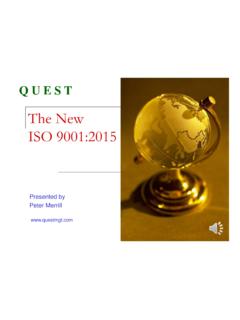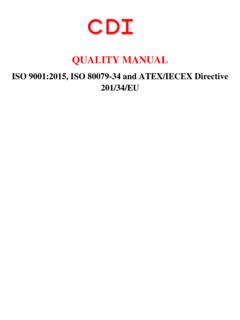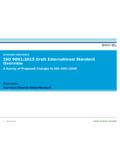Transcription of ISO 14001:2015 ExtErnal ISSuES
1 ISO 14001 : 2015 ExtE rnal ISSu ES Welcome From PJR Headquarters: 755 W. Big Beaver Rd, Suite 1340 Troy, MI 48084 Phone: 1-800-800-7910 Email: Audience for today s meeting Introduction of speaker Agenda: About PJR Benefits and Drivers Status Update / Transition Key changes ExtErnal ISSuES Certification Requirements Questions Scott Jones EHS Program Manager PJR is a leading 14001 Registrar PJR is one of the leading ISO 14001 registrars in the world Countries where PJR has certified companies to ISO 14001 : Australia Brazil European Union Japan India Malaysia Mexico Singapore Thailand United States PJR is accredited to grant certification for : ISO 9001 ISO 14001 AS 9100, 9110 & 9120 ISO/TS 16949 Responsible Recycling-R2 RIOS ISO 13485 SQF TL 9000 OHSAS 18001 ISO 27001 RCMS AND RC14001 ISO 22000 HAACP Compliance FSSC 22000 e-Stewards Benefits of Getting Certified Meeting legal requirements and improving the organization s environmental performance.
2 Management commitment and employee engagement. Business management, notably for meeting stakeholder requirements, improving public image, achieving strategic objectives, and integrating with business management systems. Supplier environmental performance. Providing a competitive advantage. Providing financial benefit. ISO 14001 : 2015 - Status Update ISO 14001 : 2015 was published on September 15, 2015 There will be a three year transition period, based on the publication date of the standards. This means the transition period will end on September 14, 2018. Companies can continue to get certified to ISO 14001 :2004 for 18 months following publication of ISO 14001 : 2015 . After 18 months from the publication date, companies can only conduct initial certifications to ISO 14001 : 2015 . ISO 14001 : 2015 Transition Process A client can transition at any time during this three-year period. ISO 14001 :2004 will remain valid until their obsolescence dates/end of transition period.
3 Certification to ISO 14001 :2004 is equivalent to certification to the 2015 version of the standards during the transition period. ISO 14001 : 2015 Transition Process In order to ensure that all clients transition on time, clients will be required to have their transition audits by 01 May 2018. This ensures sufficient time for corrective action response by the client and certification review and decision activities by the CB. As an example, a client with an anniversary date in July would need to transition in July 2017, or take their 2018 audit early. Annex SL - Structure Scope Normative References Terms and Definitions Context of the Organization Leadership Planning Support Operation Performance Evaluation Improvement ISO 14001 PDCA model Key Changes in the New Standard The emphasis on leadership The focus on risk management Emphasis on objectives measurement and change Communication and awareness Fewer prescriptive requirements Changes to ISO 14001 : 2015 Strategic Environmental Management - There is an increased prominence of environmental management within the organization s strategic planning processes.
4 Leadership - To ensure the success of the system, a new clause has been added that assigns specific responsibilities for those in leadership roles to promote environmental management within the organization. Changes to ISO 14001 : 2015 Protecting the environment - The expectation on organizations has been expanded to commit to proactive initiatives to protect the environment from harm and degradation, consistent with the context of the organization. The revised text does not define protect the environment but it notes that it can include: prevention of pollution, sustainable resource use, climate change mitigation and adaptation, protection of biodiversity and ecosystems. Changes to ISO 14001 : 2015 Environmental performance There is a shift in emphasis with regard to continual improvement, from improving the management system to improving environmental performance. Lifecycle thinking In addition to the current requirement to manage environmental aspects associated with procured goods and service, organizations will need to extend its control and influence to the environmental impacts associated with product use and end-of-life treatment or disposal.
5 Changes to ISO 14001 : 2015 Communication The development of a communications strategy with equal emphasis on ExtErnal and internal communications has been added. Documentation Reflecting the evolution of computer and cloud based systems for running management systems, the revision incorporates the term documented information , instead of documents and records . To align with ISO 9001, the organization will retain the flexibility to determine when procedures are needed to ensure effective process control. ExtErnal ISSuES Understanding the Organization and its context The organization shall determine ExtErnal and internal ISSuES that are relevant to its purpose and that affect its ability to achieve the intended outcomes of its EMS. Such ISSuES shall include environmental conditions being affected by or capable of affecting the organization. ExtErnal ISSuES Understanding the Organization and its context Examples of ExtErnal ISSuES which can be relevant to the context of the organization include: environmental conditions related to climate, air quality, water quality, land use, existing contamination, natural resource availability and biodiversity, that can either affect the organization s purpose, or be affected by its environmental aspects; the ExtErnal cultural, social, political, legal, regulatory, financial, technological, economic, natural and competitive circumstances, whether international, national, regional or local; ExtErnal ISSuES Determining the Scope of the EMS When determining this scope, the organization shall consider: The ExtErnal and internal ISSuES referred to in ; ExtErnal ISSuES Actions to address risks and opportunities prevent or reduce undesired effects, including the potential for ExtErnal environmental conditions to affect the organization.
6 Controls need to be established for environmental performance and practices of ExtErnal providers; Controls can include type of equipment, approved chemical list, etc. ExtErnal ISSuES ExtErnal communication The organization shall externally communicate information relevant to the environmental management system, as established by the organization s communication process(es) and as required by its compliance obligations. ExtErnal ISSuES Chapter 8 Operation Operational scheduling and control should pay closer attention to upstream and downstream and, in particular, outsourced processes. This also includes the environmental impacts of products and services right through to the end of their utilization. ExtErnal ISSuES Operational planning and control Communicate its relevant environmental requirement(s) to ExtErnal providers, including contractors; knowledge, competence and resources, including: the competence of the ExtErnal provider to meet the organization s environmental management system requirements; ExtErnal ISSuES Operational planning and control Consistent with a life cycle perspective, the organization shall: establish controls, as appropriate, to ensure that its environmental requirement(s) is (are) addressed in the design and development process for the product or service, considering each life cycle stage; determine its environmental requirement(s) for the procurement of products and services, as appropriate; communicate its relevant environmental requirement(s) to ExtErnal providers, including contractors.
7 Consider the need to provide information about potential significant environmental impacts associated with the transportation or delivery, use, end-of -life treatment and final disposal of its products and services. ExtErnal ISSuES Operational planning and control When determining the type and extent of operational controls related to ExtErnal providers, including contractors, the organization may consider one or more factors such as: environmental aspects and associated environmental impacts; risks and opportunities associated with the manufacturing of its products or the provision of its services; the organization s compliance obligations. ExtErnal ISSuES Emergency Preparedness and Response When planning its emergency preparedness and response process, the organization should consider: internal and ExtErnal communication process(es); Both on-site concerns and concerns with neighboring facilities the possibility of mutual assistance from neighboring organizations.
8 ExtErnal ISSuES Chapter 9 Performance evaluation Based on the extended environmental assessment, expectations for environmental performance evaluations are now also being raised. Includes performance of environmental objectives. Monitoring and measuring will also include all other corporate commitments and risks in relation to environmental performance. Guidance References Annex A Guidance on the use of this International Standard Annex B Correspondence between ISO 14001 : 2015 and ISO 14001 :2004 Bibliography Certification Steps Establish Documentation to meet 14001 requirements Training to 14001 requirements Implement 14001 requirements Conduct internal audits of system Conduct compliance evaluation Conduct review of system based on input from internal audit Contract with a certification body Complete S1 and S2 audits Address any nonconformities Certification! Certification Process PJR conducts a cursory review of documents in house prior to Stage 1 The registration audit consists of two stages: Stage 1: On-site document review of your EMS Evaluates the readiness of your organization to move to stage 2.
9 Stage 2: Scheduled 30 to 45 days after the stage 1 audit. On-site audit of your entire EMS. Nonconformities will need to be resolved prior to issuing of the certificate. Surveillance audits Scheduled at either six or twelve month intervals depending on the contract. Partial system audit. Re-certification audit On-site audit conducted prior to the third anniversary of the initial certification Surveillance visits will then continue, as before, on a 3-year cycle. Certification Requirements Please type any questions you may have. For additional technical information, please contact Scott Jones or myself using the below contact information: For a quote, please contact the sales department at: 1-800-800-7910 Scott Jones EHS Program Manager Phone: (248) 358-3388 Email: Austin Matthews EHS Assistant Program Manager Phone: (248) 358-3388 Email.

